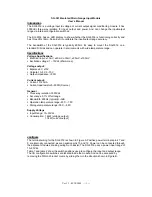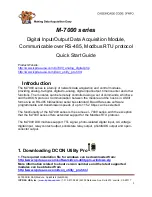
The phase selection function is design to accurately select
the proper fault loop(s) in the distance function dependent
on the fault type.
The heavy load transfer that is common in many
transmission networks may in some cases interfere with the
distance protection zone reach and cause unwanted
operation. Therefore the function has a built in algorithm for
load encroachment, which gives the possibility to enlarge
the resistive setting of the measuring zones without
interfering with the load.
The output signals from the phase selection function
produce important information about faulty phase(s), which
can be used for fault analysis as well.
Distance measuring zone, quad characteristic
separate Ph-Ph and Ph-E settings ZMRPDIS,
ZMRAPDIS
GUID-014501E7-EE0D-440F-8DC8-C44B848E49D3 v4
The line distance protection is up to five zone full scheme
protection with three fault loops for phase-to-phase faults
and three fault loops for phase-to-earth fault for each of the
independent zones. Individual settings for each zone in
resistive and reactive reach gives flexibility for use as back-
up protection for transformer connected to overhead lines
and cables of different types and lengths.
Mho alternative quadrilateral characteristic is available.
Distance protection zone, quadrilateral characteristic
(ZMRPDIS) together with Phase selection, quadrilateral
characteristic with settable angle (FRPSPDIS) has
functionality for load encroachment, which increases the
possibility to detect high resistive faults on heavily loaded
lines, as shown in figure
en05000034.vsd
R
X
Forward
operation
Reverse
operation
IEC05000034 V1 EN-US
Figure 15. Typical quadrilateral distance protection zone with Phase
selection, quadrilateral characteristic with settable angle
function FRPSPDIS activated
The independent measurement of impedance for each fault
loop together with a sensitive and reliable built-in phase
selection makes the function suitable in applications with
single pole tripping and autoreclosing.
Built-in adaptive load compensation algorithm prevents
overreaching of zone 1 at load exporting end at phase-to-
earth faults on heavily loaded power lines.
The distance protection zones can operate, independent of
each other, in directional (forward or reverse) or non-
directional mode. This makes them suitable, together with
different communication schemes, for the protection of
power lines and cables in complex network configurations,
such as parallel lines, multi-terminal lines and so on.
Phase selection, quadrilateral characteristic with
settable angle FRPSPDIS
GUID-09D0E480-C003-424E-BECD-A82BCB0052CD v1
The operation of transmission networks today is in many
cases close to the stability limit. Due to environmental
considerations, the rate of expansion and reinforcement of
the power system is reduced for example, difficulties to get
permission to build new power lines. The ability to
accurately and reliably classify the different types of fault,
so that single pole tripping and autoreclosing can be used
plays an important role in this matter. The phase selection
function is designed to accurately select the proper fault
loop in the distance function dependent on the fault type.
The heavy load transfer that is common in many
transmission networks may make fault resistance coverage
difficult to achieve. Therefore, the function has a built in
algorithm for load encroachment, which gives the possibility
to enlarge the resistive setting of both the phase selection
and the measuring zones without interfering with the load.
The extensive output signals from the phase selection gives
also important information about faulty phase(s) which can
be used for fault analysis.
A current-based phase selection is also included. The
measuring elements continuously measure three phase
currents and the residual current and, compare them with
the set values.
High speed distance protection, quadrilateral and
mho ZMFPDIS
GUID-2E34AB7F-886E-499F-8984-09041A89238D v11
The high speed distance protection (ZMFPDIS) provides a
sub-cycle, down towards a half-cycle operate time. Its
seven zone full scheme protection with three fault loops for
phase-to-phase faults and three fault loops for phase-to-
earth faults for each of the independent zones, which makes
the function suitable for applications with single-phase
autoreclosing.
Each measurement zone is designed with the flexibility to
operate in either quadrilateral or mho characteristic mode.
This can be decided separately for the phase-to-earth or
phase-to-phase loops. Out of the seven zones, one zone
has fixed directionality to reverse, one zone has fixed
Line differential protection RED670
1MRK 505 379-BEN R
Version 2.2
Hitachi Energy
39
© 2017 - 2022 Hitachi Energy. All rights reserved
Содержание Relion 670 Series
Страница 1: ...Relion 670 SERIES Line differential protection RED670 Version 2 2 Product guide ...
Страница 191: ...191 ...
















































